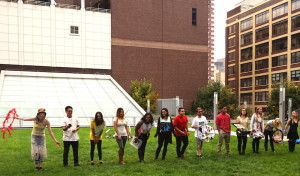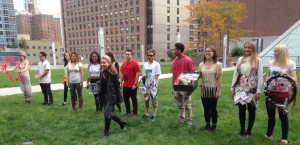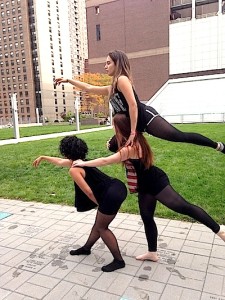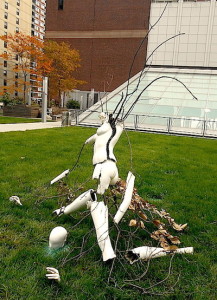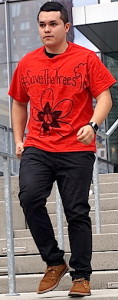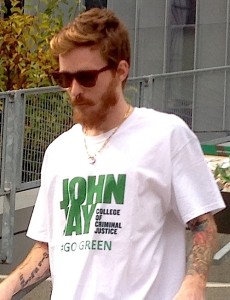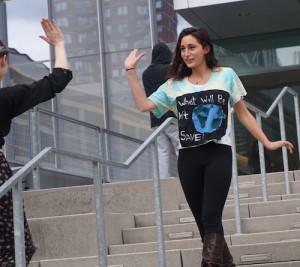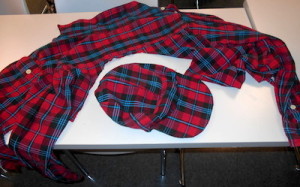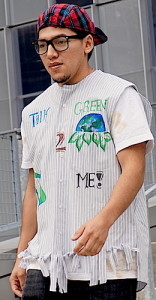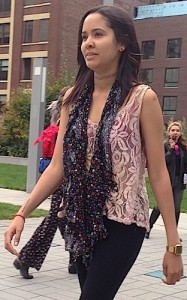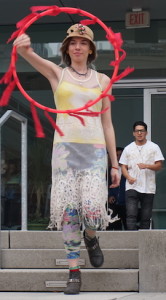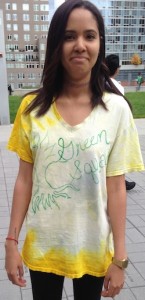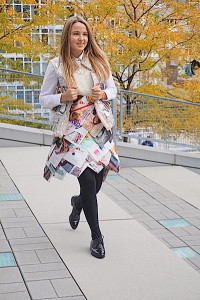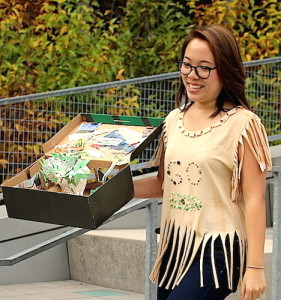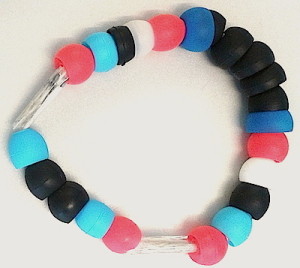Eco Fashion Show
Eco Fashion Show at the John Jay College
By Milena Popov
Photo by Carolina Fernandez
Photo by Elijah Wilson
John Jay’s first ever Eco Fashion Show happened on Tuesday, October 27, 2015 during community hour on the Jay Walk (the college’s rooftop garden). The event, hosted by Professor Milena Popov and her students from ART 191: Eco Art and Design, hoped to raise awareness of environmental problems and to provide some ideas for solutions. Eco Art and Design students showed their designs on a runway accompanied by a guitar player, and followed by a dance performance choreographed by student Laura Estrada. The show also had a site-specific art installation created by student Rui Jun Chen that served as the backdrop for both the runway and the dance performance.
Photo by Lindsey Kayman Photo by Milena Popov
Besides t-shirts with slogans such as Earth is Our Only Home, Do You Love Your Planet?, the audience was able to see a wide variety of eco clothing and accessories designed by John Jay’s student-eco designers. While some designers used natural, non-toxic dyes, such as coffee, green and black tea, blueberries, beets and turmeric to color their old clothes, others cut up their old dresses, pants, and shirts to create fashionable scarfs, hats, and shirts, or used found objects to create interesting applications for their old clothes. After learning how to sew in the Eco Art and Design course, Cesar Ponce sewed an entire baseball hat, using fabric from his old flannel shirt. Stephanie Fossum used her old pants to create a very fashionable black top, and dyed her old t-shirts with turmeric, beets, and coffee to create beautiful pink and bright yellow tees, and a beige lace dress. Yakeysi De La Cruz and Martin Zaimi created elaborate cut-out coffee-dyed tees with sea-shell and slogan applications. Similarly, Jaclyn Banayan and Kimberly Wright designed intricate cut-out clothing, while also using beautiful painterly applications. Carolina Fernandez also used her painting skills for slogan tees. Michelle Sharkansky, Samantha Tejada, and Yakeysi De La Cruz, by contrast, used entirely different eco-fashion materials to make their designs – newspaper and magazine cut-outs. Using various eco-fashion techniques, students gave a new life to old, discarded clothing, objects and materials.
Models wearing Antolina Garcia’s t-shirts with slogans #Save The Trees and Earth is Our Only Home (photo by Carolina Fernandez) and Jerry Camacho’s #Go Green t-shirt with printed green letters on top of his John Jay College t-shirt (Photo by Carolina Fernandez). Coffee-dyed cut-out t-shrit with sea shell application designed by Yakeysi De la Cruz paired with assemblage by Kimberly Wright (photo by Elijah Williams). T-shirt – What Will be Left to Save? designed by Kristen Craig (phot by Carolina Fernandez). Model wearing hat designed by Cesar Ponce and beautifully hand-painted slogan Talk Green 2 Me by Kimberly Wright on her cut-out redesigned shirt (photo by Milena Popov and Carolina Fernandez). Beet-dyed lace top by Stephanie Possum and old dress-cut out scarf by Jaclyn Banayan (photo by Lindsey Kayman). Stephanie Fossum designs parked with redesigned hat by Elijah Williams (photo by Carlina Fernandez). Tumeric-dyed top by Stephanie Fossum (photo by Lindsey Kayman). Newspapers and wrapping paper vest by Michelle Sharkansky paired with newspaper skirt by Samantha Tejada.
To design jewelry and tote bags, John Jay’s eco designers used various found objects, from newspapers and magazine cut-outs to bubble wrap, broken pottery, pressed flowers, pebbles, rubber earphone buds, soda-tabs, paper clips, safety pins, other found objects and discarded jewelry pieces. Besides jewelry, some assemblages created in the classroom were worn as accessories in the show, too.
Found objects and beads bracelet and ring by Michelle Sharkansky.
Paper, safety pins, and beads necklace by Stephanie Fossum.
Student-made assemblages representing biodiversity loss and wildlife crime were worn as accessories at the show by Eco Art and Design students that have founded the College’s Animal Rights Club.
The fashion presented in this show was nothing like mainstream fashion. Mainstream fashion uses more than 8000 toxic chemicals in material production (from pesticides to toxic dyes, color stabilizers and flame retardants) that are damaging to human health and the environment. Once discarded, these products fill landfills, creating more pollution. As stated in the Eco Fashion Show’s brochure, everyone can make a difference and lower their individual ecological fashion footprint by making good choices, such as recycling clothing, creating DIYs, donating clothing, exchanging clothing, selling or buying second-hand clothing, buying eco fashion, buying only what is necessary, or at least buying fewer items. The Eco Art and Design students already have an idea for a larger eco fashion event to be held at the College, one that would include student workshops, a clothing donation station, film screenings, etc. . .
